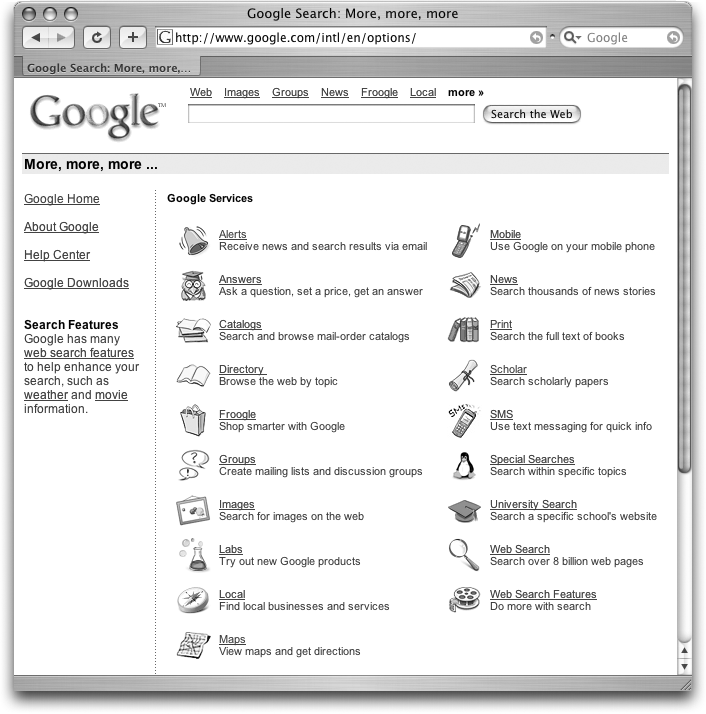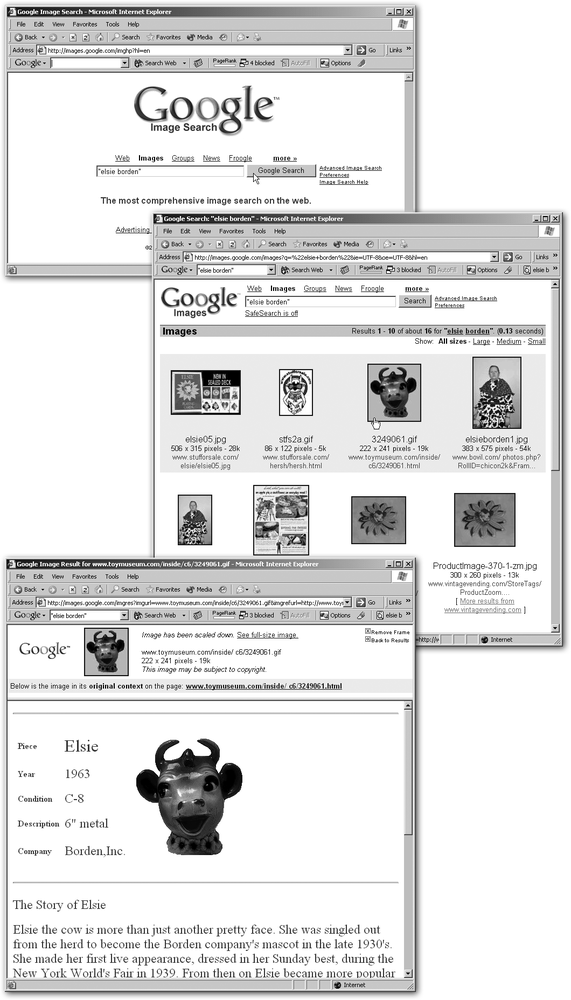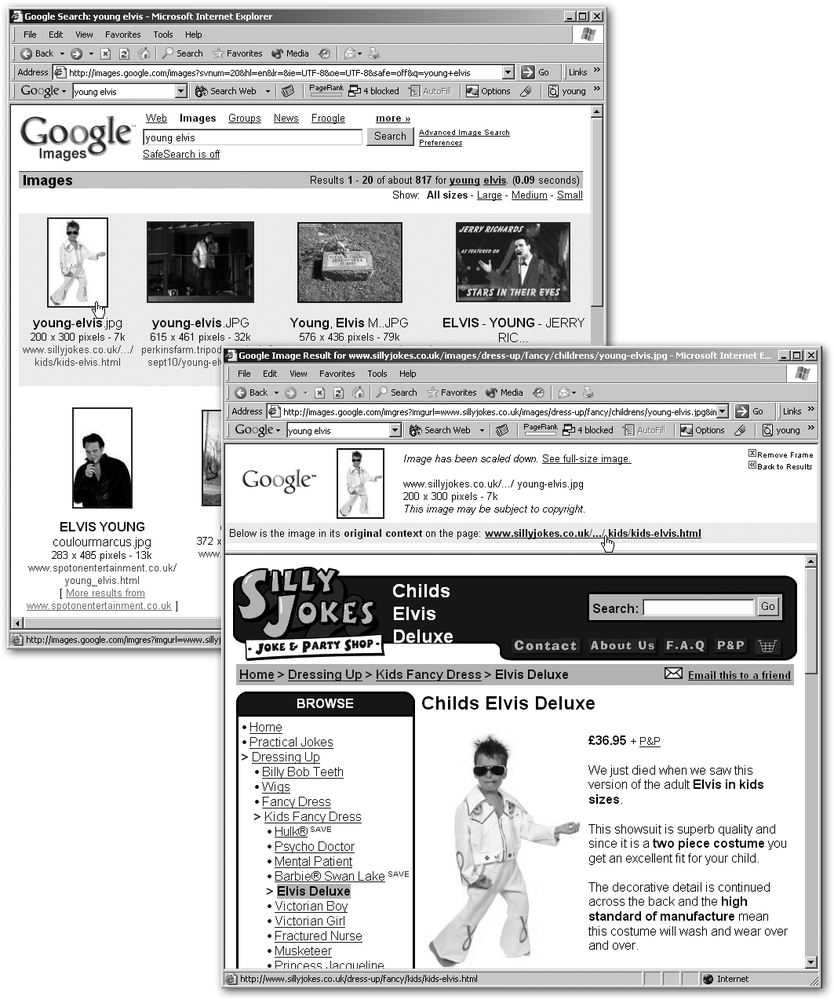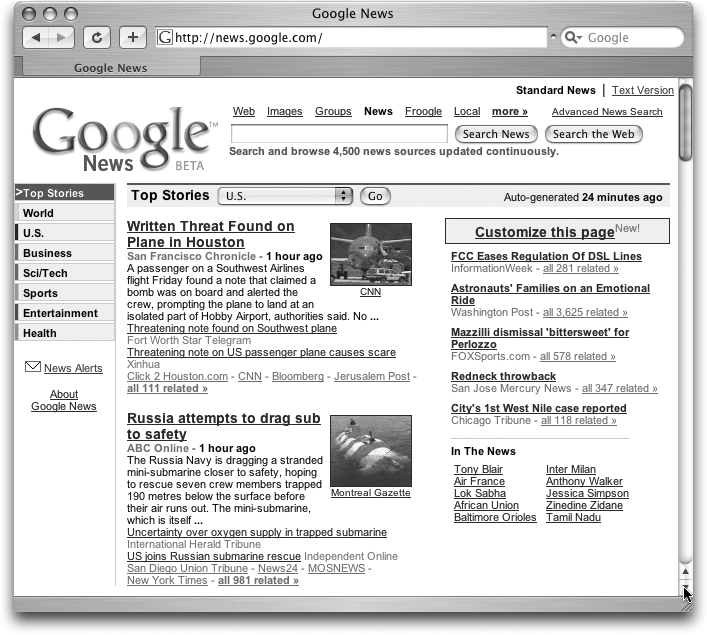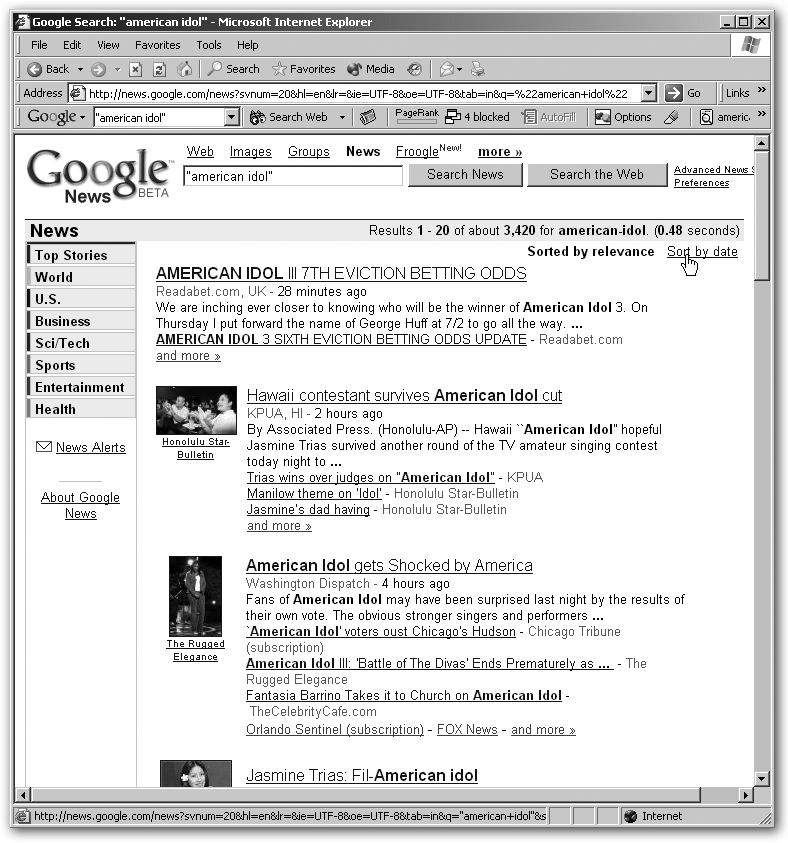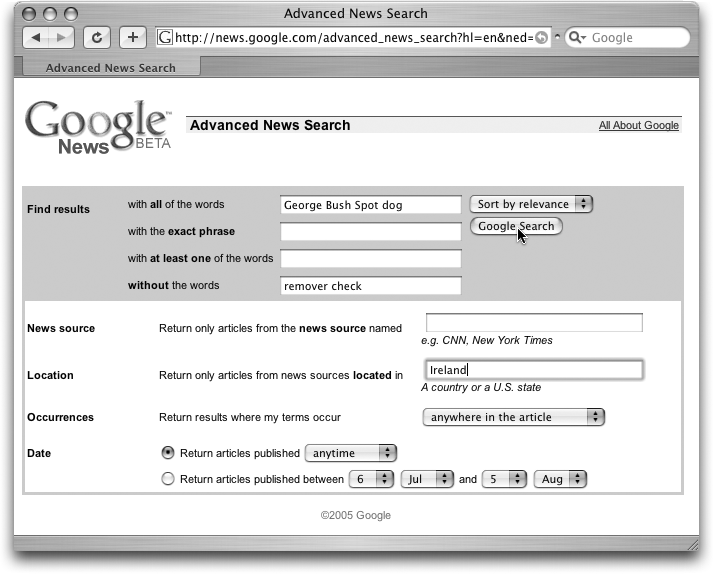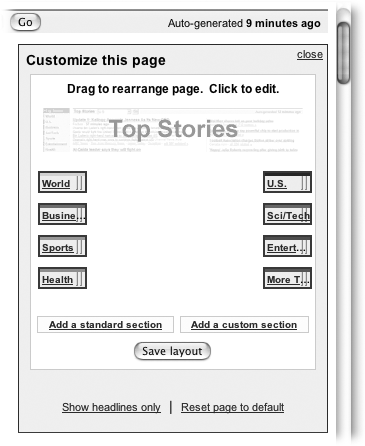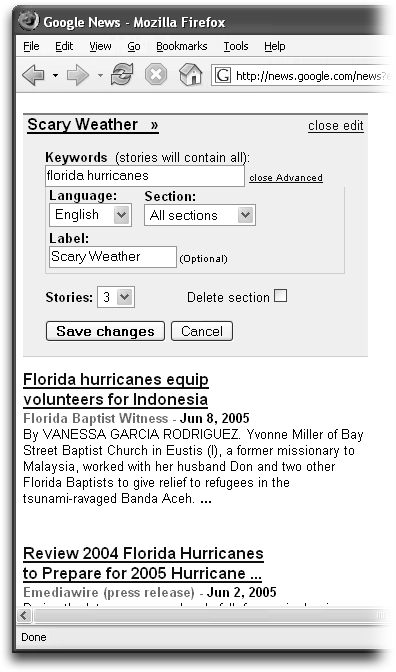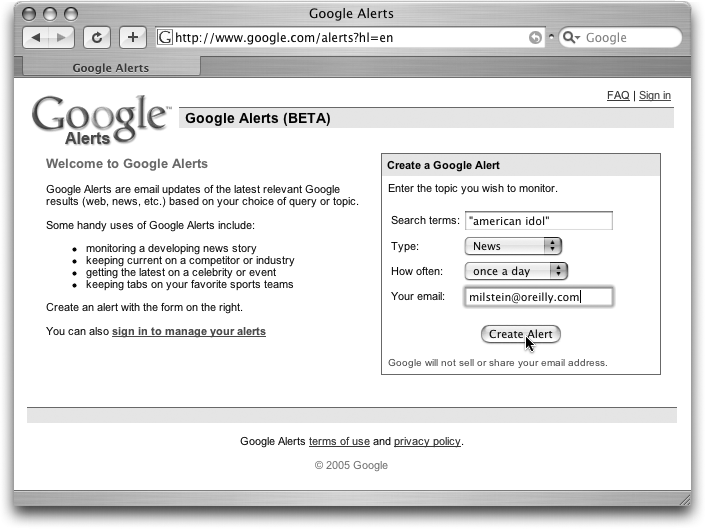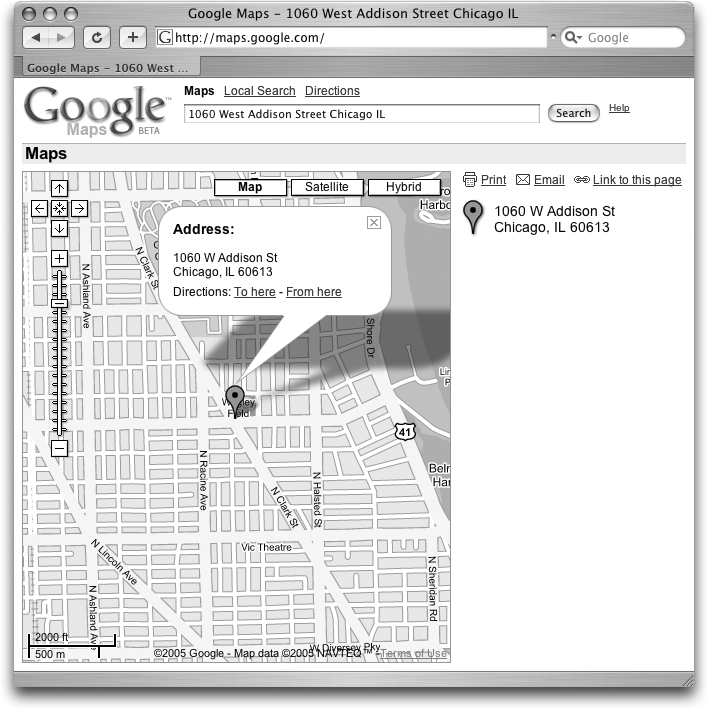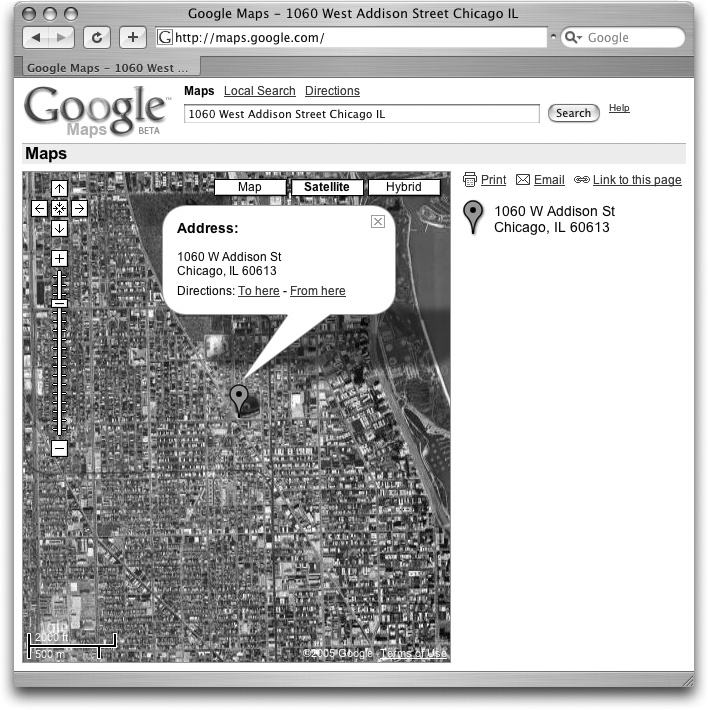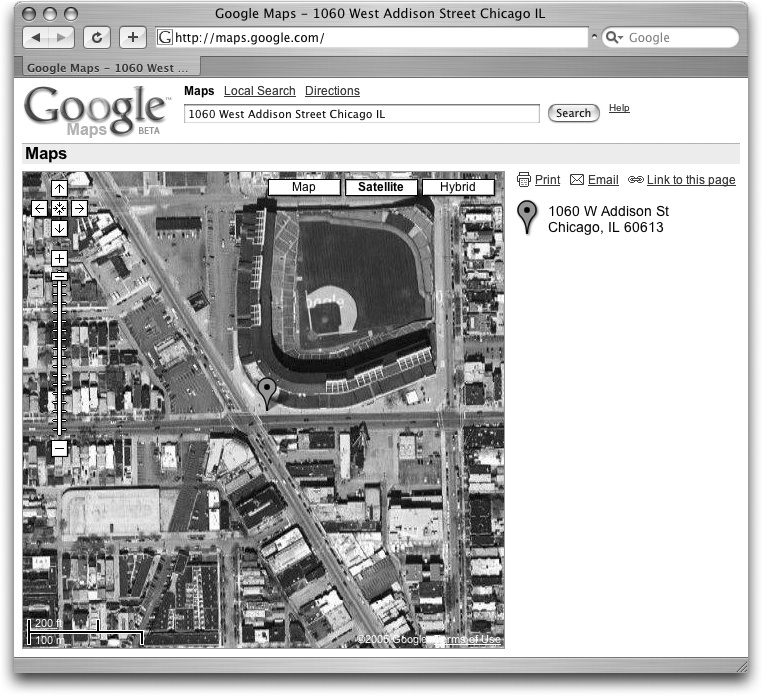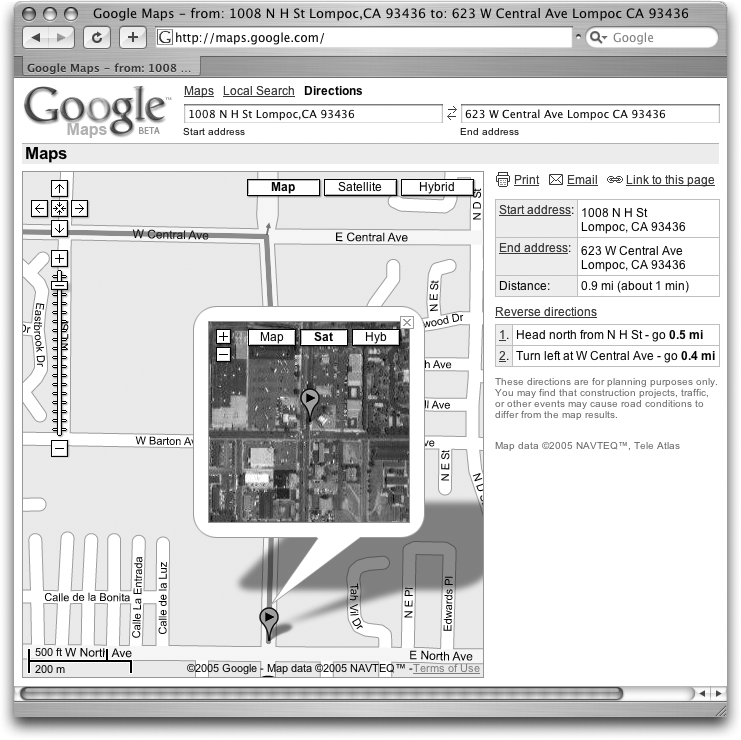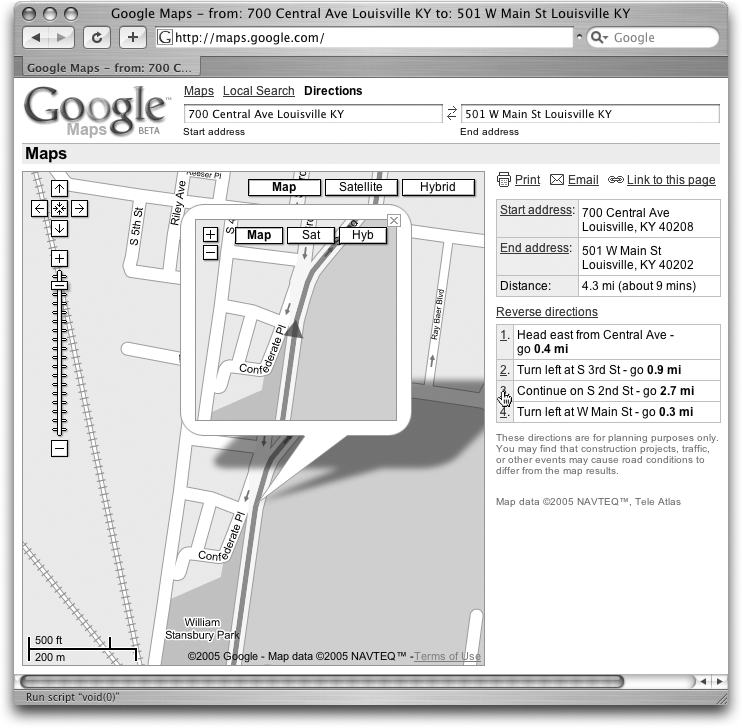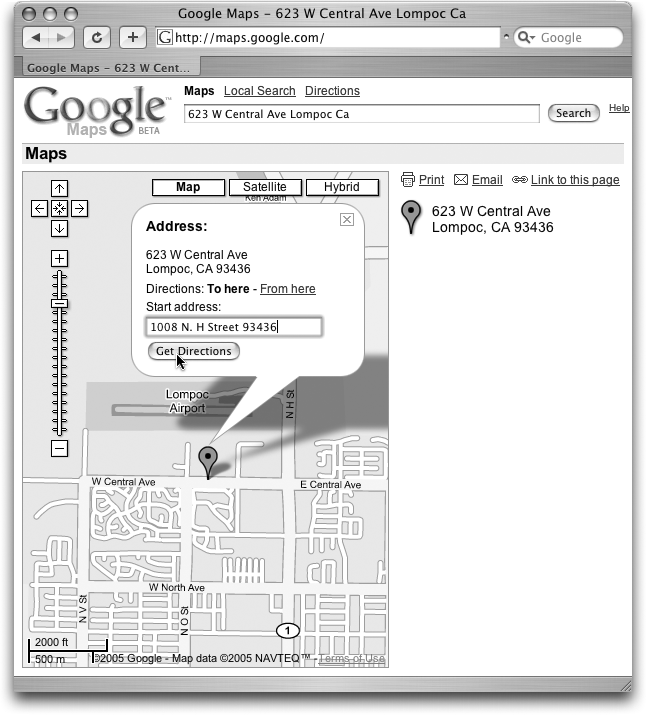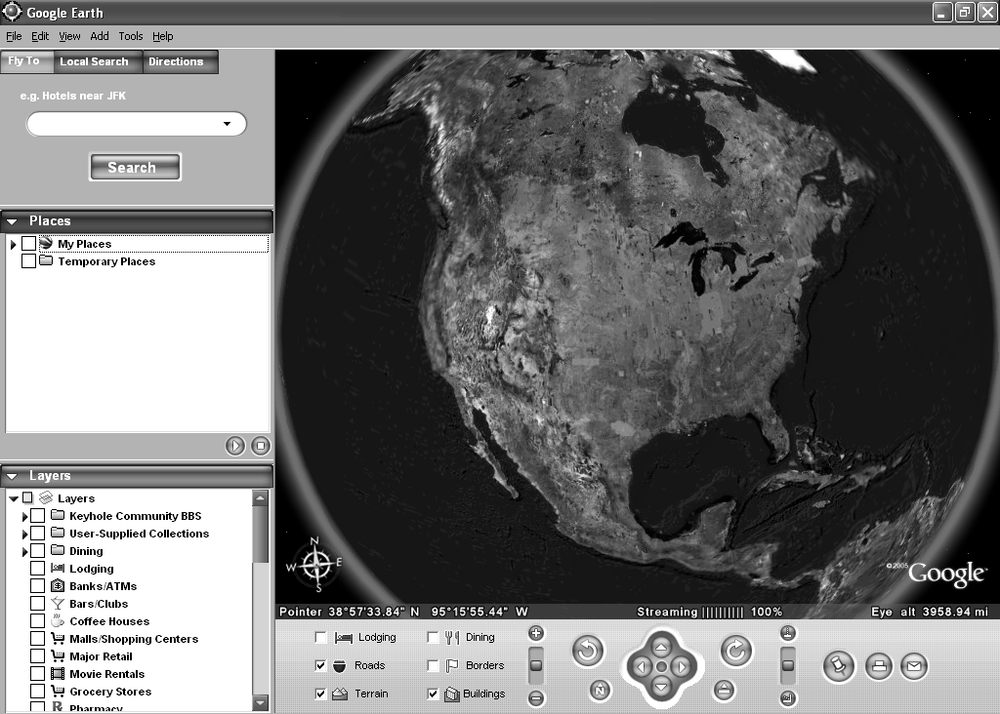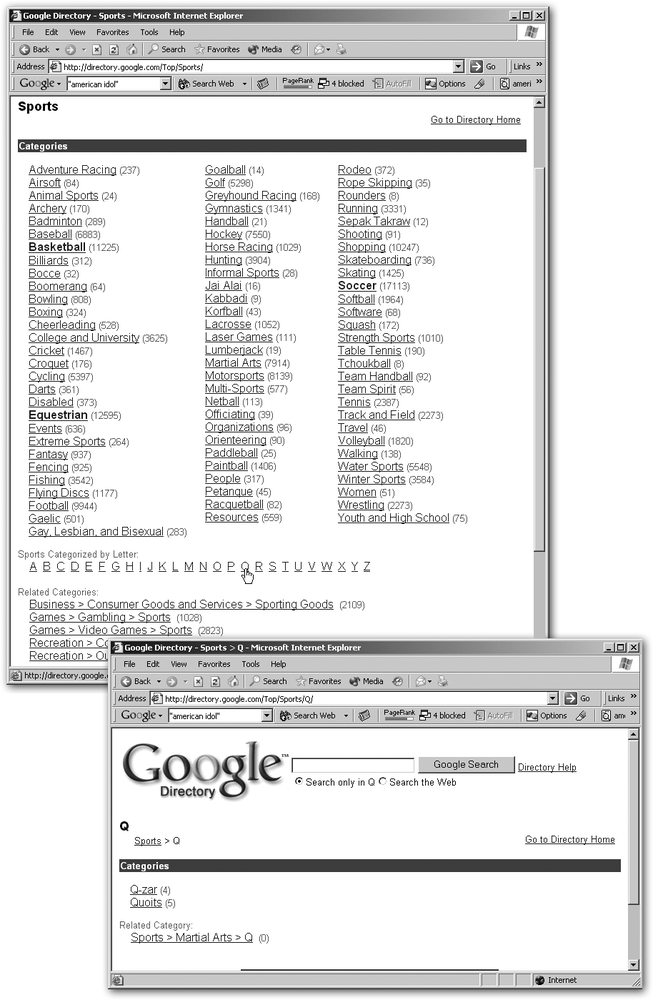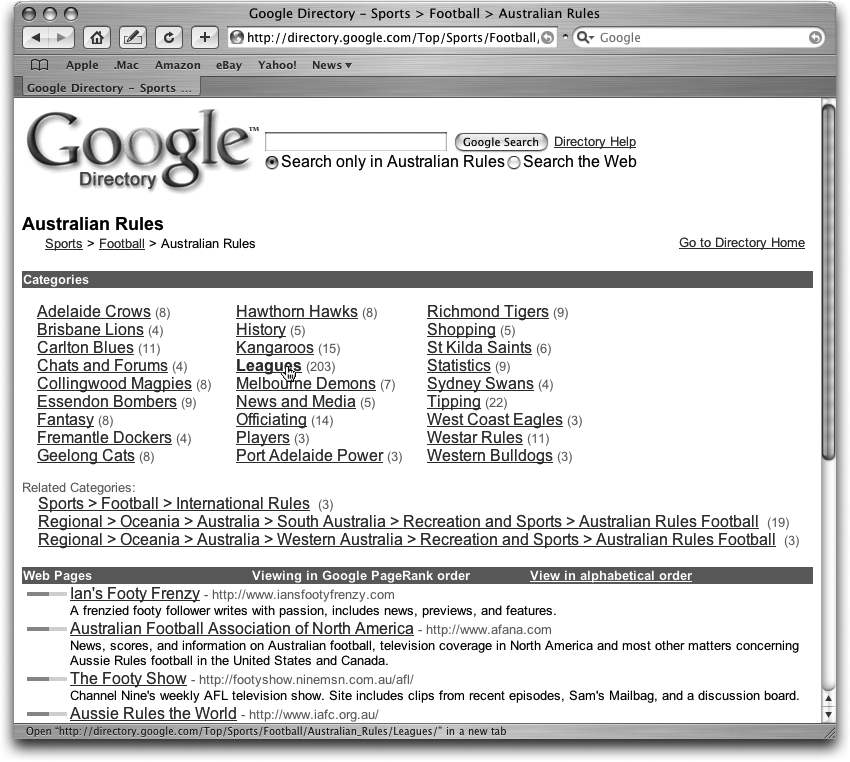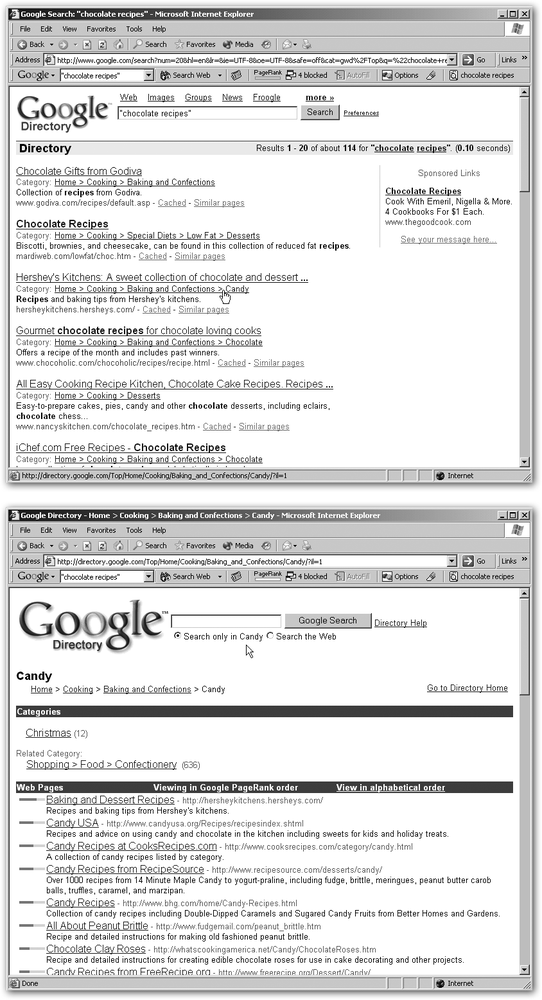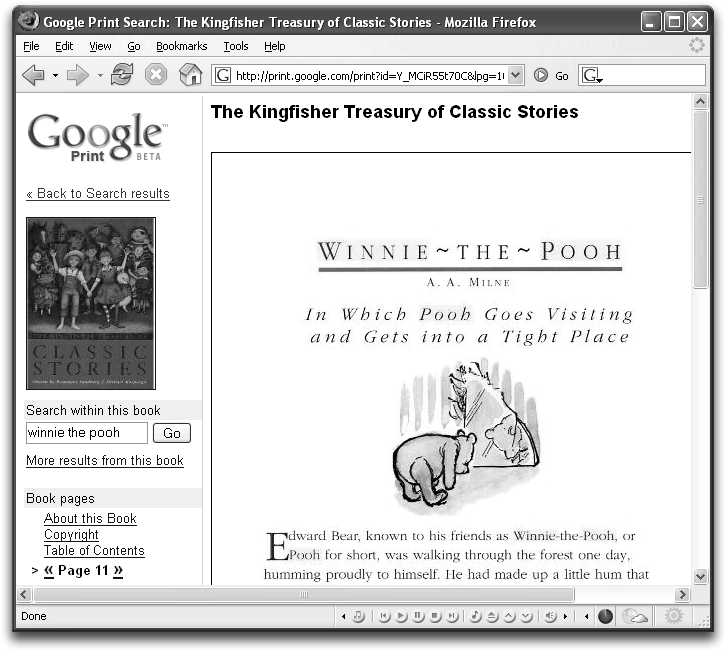Chapter 3. Googling Further: Images, News, Maps, and More
Normally, when you run a Google search, you’re asking Google to look for your search terms on any Web page it’s tracked. But the Web can be sliced in many ways, and Google has created a bunch of alternative systems for helping you find things.
For example, when you want to find a picture of somebody, you could type in his or her name followed by a few file types used for images, like "Mick Jagger” jpeg gif, and hope for the best. Problem is, Google gives you any site that mentions Mr. Jagger and that has JPEG or GIF files—but not necessarily pictures of the thick-lipped star. You could be drowning in photos of Keith Richards for days before you get any search satisfaction. Better to use Google Images, a special search that finds only pictures.
But the fun doesn’t end with images. Google News lets you search for and organize news stories. Google Maps helps you find addresses, directions, and businesses all over the country. The Google Directory gives you a way to find information by category rather than keyword. And Google Print lets you search inside books.
This chapter explains all these features, and the following two chapters cover a few other Google goodies: Groups, Answers, Froogle, and Catalogs. Figure 3-1 shows you where to find all of these services.
Knowing how to use Google’s alternative searches can help you tap amazing resources most people overlook.
Google Images
Google’s primary search looks for text on the Web matching your keywords. But Google also lets you search through a bank of billions of images on the Web. Because most pictures have keywords associated with them, you can type in text to find them. (To figure out what a picture contains, Google reads the text on the page around it, the caption if there is one, and other variables, producing surprisingly accurate results.)
The Image Search is terrifically useful when you want to find drawings or photos for use on your Web site, or for inspiration or imitation in your own artwork. It’s even a good way to find things like desktop icons, maps, and posters. It can help you figure out if that familiar looking guy on the Stairmaster next to you at the gym was actually Benicio del Toro, and it can show you instantly what a Smart Car looks like. It can also be handy if you’re a collector: The objects you’re interested in may well be featured in pictures on Web pages. Figure 3-2 shows how image searching works.
Note
If you have a Web site with pictures that you don’t want Google to find, http://images.google.com/remove.html#images tells you how to remove the images from Google’s orbit.
Searching for Images
Searching for pictures is as easy as typing a keyword or two into the blank search box at http://images.google.com and then pressing Enter. Image searches are not, however, as reliable as text searches. And, unfortunately, multiword queries tend not to work well in Google’s Image Search. But single-word queries can give you thousands of results, which is often too many to be useful.
Here are a few tips for finding what you want:
Keep it short (but not too short). When you can be both brief and specific, you’re most likely to get what you want. For example, if you need a drawing of a male Muppet, a search for Bert turns up an overwhelming 314,000 results. A search for Bert Ernie gets you more than 6,500 pictures. And Bert Sesame Street weighs in with just over 1,700 images.
Experiment and be patient. The keywords Google associates with images are not always consistent. Thus, while it’s generally a good idea to use very specific search terms, trying out variations can pay off, too—especially when your attempt to be brief and specific, as suggested above, doesn’t fly. For example, if vintage Cadillac convertible and 1953 El Dorado don’t pan out, try 1953 Cadillac convertible or Cadillac El Dorado.
Try the Advanced Image Search feature. Google’s Image Search has its own advanced search page, explained next, that’s separate from the advanced page for regular Web searches. It can help you narrow down a search by file type, size, or coloration (black and white, grayscale, or full color). And, as explained in the box in Section 3.1.2, Advanced Image Search also lets you change the level of filtering Google uses for your results. Finally, the page guides you through keyword choices and lets you specify a site or domain Google should restrict your image search to.
Tip
Want to see how other people use their digital cameras? Cruise over to Flickr (www.flickr.com/photos) to browse the photographic journeys of people who’ve signed up for the free photo-sharing service. You can see everything from moody art shots to casual cellphone snaps—and lots and lots of pictures of member’s dogs.
Use syntax. Google lets you use four syntax elements to focus your image searches. All four are the same ones used in Google’s regular Web search (Section 2.6). Keep in mind that because image searches are something of a crapshoot, you’ll probably have to fiddle with these syntax elements till you find exactly what you’re looking for.
Intitle can be a good way to hone searches because it looks for your keywords in Web page titles, which removes some of the guesswork for Google about what a page contains. Use it like this: intitle:"taj mahal“.
Inurl works strangely in Google’s Image Search, because when Google records the text on a Web page, it considers certain elements—like JPG extensions—as part of the URL. Thus, if you search the image bank for inurl:poker, Google might show you a picture from the URL www.dogsplayingcards.com/velvet.html because that page contains a picture called poker.jpg. That weirdness aside, inurl is like intitle in that it can whittle your results from tens of thousands of images down to a manageable number, like a few hundred.
Filetype is available as a choice in the Advanced Image Search, too, although you can use it to search only for the formats Google keeps track of—JPG, GIF, and PNG. The one trick with this operator is that you can specify filtetype:jpeg and filetype:jpg, which give you different results (the advanced page includes only an option for JPG). Use it like this: "poker chips” filetype:jpg.
Site is also part of the Advanced Image Search, and you can use it to limit your searches to particular sites or domains, which include segments of the Web, like .com and .net, and also countries, like .au (Australia) and .fr (France). The site syntax is especially handy when you want to restrict your results to images from Web sites from a certain country, like this: sitcom site:UK, which gives you pictures from British sites. And if you know that something you want to see is somewhere on one large site, use it like this: friends site:nbc.com.
Tip
To find country codes for the Web, look on Google’s Language Tools page (www.google.com/language_tools). About halfway down the page, the section labeled Visit Google’s Site in Your Local Domain shows you the URLs for dozens of countries. The last two-letter segment of each is the country code.
Advanced Image Search
You can get to the Advanced Image Search via the Images main page, which has a link to it on the right side of the screen. Alternatively, every Images results page has a link to it above the search box at the top of the screen. Figure 3-3 shows the advanced search page.
The Advanced Image Search has six elements you can tweak. SafeSearch is explained in the box in Section 3.1.2; the others are:
Find Results. This section is where you type in your keywords. You can use all or any of the four search types, which work as follows:
—”Related to all of the words" means Google looks for every word or phrase you ask for, but not necessarily in order. This option works nicely when you don’t care whether a picture is of a 1953 Cadillac or simply a picture of a Cadillac taken in 1953. —”Related to the exact phrase" is like putting quote marks around your terms, and means Google looks for all your words in the order you type them in. If you typed 1953 Cadillac here, you’d most likely get only pictures of 1953 Cadillacs. Figure 3-3. The Find Results section lets you fill in query words that are related to the picture you want to find. Because the Web has no standard technical system for labeling images, and because two different Web sites could legitimately call the same picture “car” and “Cadillac,” Google has to perform search jujitsu and look at the text near images to figure out which pictures might match your terms.—”Related to any of the words" means Google shows you pictures that are near at least one of your words, but not necessarily all of them. This search gives you 1953 Cadillacs, but also Cadillacs from other years, and pictures of other things from 1953 or taken in 1953. —”Not related to the words" leaves out pictures that are near the words you type in here. For this search to work, however, you have to have some keywords in one of the other boxes in Find Results. For example, if you want pictures of a vintage El Dorado, but you’re not interested in the Dreamworks movie El Dorado, try typing Cadillac El Dorado in either of the first two boxes, and type Dreamworks in this last one. Google gives you lots of pictures of cars and excludes cartoon stills from the movie. Size. People measure electronic images in two ways: by dimension (which can be in inches, centimeters, pixels, and so on) and by the amount of space a picture takes up on your hard drive, usually expressed in kilobytes. Google lets you narrow down your results to include only images with rough dimensions, measured in pixels. (Google also tells you how big a file is in kilobytes, but it doesn’t let you search for this factor.)
Dimension matters in a few cases. First, if you’re accessing the Internet over a dial-up connection, image searching can be slooooow. While dimensions are no guarantee of weight in kilobytes, smaller pictures are often made up of less data—and therefore load faster. Second, some things, like maps and posters, tend to show up in larger dimensions. And if you’re specifically looking for pictures to use on your desktop icons or to fill a space of a certain size on your Web site, this feature can help you hit pay dirt.
Google has three sizes to choose from: small (about 100 x 100 pixels), medium (around 200 x 200 pixels), and large (everything else). You can simply pick the one you want from the menu. Like all elements that narrow down an image search, picking a certain size can lead to maddeningly few or sometimes no results, so it’s best to stay flexible when you can.
File types. Google keeps track of files in three formats: JPG, GIF, and PNG. It’s best to leave this setting at “any filetype” since choosing one eliminates lots of results. But, obviously, if you need a certain file type and you don’t have access to a graphics program that can convert images, this feature is crucial for successful searching.
Coloration. Your choices here—black and white, grayscale, or full color—can produce wildly different results. Black and white images tend to include diagrams, charts, line drawings, symbols (like the outline of a woman from a restroom door), cartoons, sheet music, and maps. Sometimes photos show up in a black-and-white search, and sometimes they don’t. Grayscale searches, however, often produce photos as well as drawings of various kinds. And full-color searches usually give you primarily photos, followed by cartoons and other drawings.
In addition to helping you find different kinds of pictures, the coloration feature can be a boon to dial-up searchers. Both grayscale and black and white pictures are often much, much leaner than color pictures and thus load significantly faster.
Domain. If you know the picture you want is on a particular Web site, you can use the domain feature to limit Google to that site. For example, if you want to see official pictures of Microsoft’s Windows logo, try windows as your keyword, and then in the domain box, type www.microsoft.com.
Of course, you can also use the domain feature to tell Google you’d like to search only in one country, like .de (Germany) or .sp (Spain), or in a particular segment of the Web, like .edu, .org, or .com. This option is handy when, for example, you’re looking for things to buy (try limiting your search to the .com domain). Want to find computer science department logos? Try looking only in .edu.
Reading Your Images Results
It’s pretty easy to navigate through a page of image results. You get a bunch of thumbnail-sized pictures, you click one you want to see, and Google shows you a larger picture of the image and the page it came from. But the image results have a few nooks and crannies you might miss. Figure 3-4 shows you what to look out for.
Tip
If you have a broadband Internet connection and a fairly large screen, image results are usually easiest to flip through if you’ve got about 20 or 30 on a page, rather than the 10 Google comes set to. From the preference page (www.google.com/preferences), you can change the number of results Google shows you for every search. Once you’ve made the change, Google saves that setting unless you change it again.
Google News
Most of Google’s services help you find things on the Web only when you ask for them. Google News (http://news.google.com/) does the opposite: It goes out and finds news stories throughout the day, continuously updating its news page (Figure 3-5), or even sending you email as stories develop. Google culls articles from thousands of online news sources, and then presents them by topic (“Fans, Industry Mourn Johnny Cash”) and by category (Entertainment).
Unlike most other news services, Google News uses sophisticated computer algorithms, rather than sophisticated humans, to group and categorize stories. The advantage to this system is that Google can gather a lot more stories a lot faster than most news aggregation services. In addition, because people aren’t involved, the service isn’t influenced by politics or ideology, so you get a range of viewpoints on most stories. The disadvantage is that sometimes, those computerized editors misunderstand things and post a story about, say, the Gaza Strip in Entertainment.
Note
Google considers the news service to be a beta offering, which means the company does not claim that it’s ready for prime time. In practice, this means very little. Google News works so consistently, you may never notice any glitches.
Google News is great for learning about breaking news, for comparing the way different news organizations cover the same story, or for seeing how a story has developed over the past month (the service archives stories for 30 days). You can also run a keyword search in Google News, as described in the next section.
Searching Google News
You can run a search in Google News just the way you would run any regular Google search of the Web. If you type your terms into the blank search box at the top of any Google News page and then press Enter, Google gives you a list that looks like the results in Figure 3-6, including results up to a month old.
If you find yourself with tons of irrelevant results, you can take two courses of action to narrow things down. Either use the advanced search feature described in the next section, or use one of these two syntax elements:
Intitle searches for your words in the article title. Use it like this: intitle:"presidential hopeful“.
Figure 3-6. Google News is set to show you 30 listings on a page, sorted by relevance (as assessed by Google). You can also sort the results by date, which lets you track a story’s development. Simply click “Sort by date” toward the upper-right corner of the page, which reorders the stories from most recent to oldest. If you want to change the number of results on the page, move your cursor to the end of the URL in your address bar and type in: &num=50 (make that number however many listings you’d like to see). To read a full story, click its title.Source restricts your results to stories from one news outlet, like the Washington Post or CNN. If your source has more than one word in its title, you have to use underscores to link them together, not quote marks, like this: SpongeBob source:newark_star_ledger.
Maddeningly, Google does not publish a list of the sources it gathers stories from, so you have cull sources from existing stories or do some guessing (if source:times doesn’t work, try source:new_york_times).
Advanced News Search
When you want to limit your keywords or home in on results from a particular time frame or location, the Advanced News Search page, shown in Figure 3-7, is the place to head. You can either point your browser to http://news.google.com/advanced_news_search, or you can jump to it from the main Google News page—there’s a link near the top.
Here are the elements you can fine-tune with the Advanced News Search:
Find results. As in the regular advanced search (described in Section 2.2), this section gives you four ways to specify the keywords you’d like Google to search for. If you want to exclude something by filling in the last box (“without the words”), you also have to fill in one or more of the first three boxes. Exclusion is one of the strongest tools you have at your disposal, letting you search, for instance, for Art Garfunkel without Paul Simon. This section also includes a menu that lets you select whether Google shows you results listed by relevance or by date.
News source. Like the source operator, this option lets you tell Google which news outlet you’d like results from. To use this feature, you also have to fill in at least one of the keyword boxes; you can’t simply say you’d like to see stories from Al Jazeera for the past week without giving Google some search terms, too.
Location. When you’re searching for articles on potatoes, here’s the place to tell Google that you want stories only from news sources in Idaho. This is also a handy feature if you’re trying to track events in other countries, like soccer matches in Spain, that aren’t likely to be covered by U.S. sources.
Occurrences. This menu gives you the choice to search for your keywords anywhere in an article, in the headline only, in the body text only, or in the URL only. This feature is useful when you’re searching for something that simply gives you too many results and you want to weed out a few thousand. Use the headline or URL options when you have a sense that your topic may be the main idea in a story (Ozzy Osbourne injured); limit your search to the body text if you want something offbeat (fifth place in British pop charts).
Date. In this section, a menu lets you choose to see articles from the last hour, day, week, or month. Alternatively, you can specify stories from a single date or range of days during the last month. Unfortunately the Google News archive goes back only 30 days.
This feature is seriously helpful, because a normal Google Web search lets you narrow your results down only by the day on which Google last recorded the page, or possibly on the day a page was last changed—neither of which is too useful for most searches. Here you can see what Tiger Woods has won since the beginning of the month, what Justin Timberlake was doing on New Year’s Day, or get the very latest on the return of AbFab.
Browsing Google News
To browse through recent stories, you can simply scroll down the main page to see the top stories in each category. Or you can click the colored links on the left to jump to a full page of stories for each category.
Tip
If you have a dial-up connection, you can speed up the delivery of Google News considerably by viewing the service without photos. In the upper-right corner of the page, click Text Version. To return to the version with photos, click Graphical Version near the top of the page.
Google helpfully clusters stories together by topic. An individual story consists of a headline you can click to go to the original site (if that site requires registration, Google makes note); the first paragraph of the story; links for related headlines from several other news sources; links to other sources that have covered the story; and a link for a listing of related stories, which takes you to a page of results like that shown in Figure 3-6.
Tip
How fresh is the news Google is feeding you? There are two ways to tell: 1) Toward the top of the page, under the search buttons, is a note, “Auto-generated 4 minutes ago,” or however recently Google updated the page (usually very recently); and 2) each story tells you when its native Web site posted it.
If you want your news from sources based primarily in another country, or in another language, Google News comes in other flavors: Australian, Canadian, French, German, Indian, Italian, and so on. The links for the international versions are at the bottom of the main page.
Customizing Google News
Some people don’t care about sports, and others could really do without entertainment news dominated by constant coverage of celebrity couples going out to dinner. Fortunately for the headline hound with a discriminating nose for news, Google News can be customized—meaning you can rearrange your topics and sections on the page in the order you want to see them, delete subjects you don’t care about, and make your own sections to gather news on any topic of particular importance to you.
To customize your Google News, click the “Customize this page” link on the top-right side of the main page. This opens a pane like the one shown in Figure 3-8 that displays the current layout of the page and where each section is positioned.
The Top Stories area is anchored to the top of the page, but you can change up the categories below. Drag the topic blocks into the order you want to read them, and if you want to ditch a topic entirely, just click it and then on the screen that appears, turn on the checkbox next to “Delete section”.
You can pick the international edition of Google News to use for a section’s stories as well: Click the section name and then choose the country of origin for the news you wish to see. This can be very helpful if you want to keep up with the latest entertainment news from Germany, or keep tabs on what French scientists are working on.
If you click the Save Changes button, the Google News page rejiggers itself to your specifications.
Tip
You can spread your version of the Google News page around to your pals or even to your other computers. Scroll to the very bottom of your customized page and click on “Share your customized news with a friend.” The URL for your version of Google News pops up onscreen, and once you cut and paste it into an email message and send it off, you can use that link to lead yourself (or your friends) back to your personalized page.
Adding your own news sections
Customizing Google News means more than just shoving sections around on the page. You can create completely new sections based on a few keywords pertaining to a topic you want to keep an eye on, like the hurricane forecast (if you live in Florida) or the antics of the British royal family (if you happen to be an Anglophile). You can have up to 20 standard and customized sections on your Google News page.
It takes just a few steps to add your own section from scratch:
Click the “Customize this page” link on the main Google News page
The link may be labeled “Edit the customized page” link if you’ve already been in there tinkering. At any rate, the page-editing panel appears.
Click the link for “Add a custom section.”
In the box like the one shown in Figure 3-9, you can add the keywords that you want to appear in the collected news, like florida hurricanes or tennis tournaments.
Select the number of stories you want to appear on the page.
Use the drop-down menu to choose between one and nine stories to be displayed on the page.
Click the Advanced link to further finesse your section.
In the Advanced area, you can add a custom label for your new section, like Scary Weather or Grand Slam, to describe this collection of news stories you’re gathering. The menus in the box let you choose the language you want to use for your news stories and the section you want to draw them from. For example, you if you want to watch for stories about Apple Computer’s fiscal health, use Apple Computer as your keyword and select Business from the drop-down menu under section.
Click the Add Section button
This pops you back out to the panel where you can rearrange your news blocks. Position your new section where you want to see it and click the Save Layout button. To fold up the page-editing panel, click the Close link at the top.
Once your new section lands on the Google News page, you can tweak its settings by clicking the Edit link next to its label, as shown in Figure 3-10.
If you decide that you’ve bungled up the works or want to revert back to the generic Google News page, click the “Edit this customized page link” and tap the “Reset page to default” line at the bottom of the panel.
Getting the News Delivered
Browsing and searching for stories is all well and good if you’re serving ten years to life. But if you’re too busy to click around Google News looking for breaking stories all the time, you can have Google email you updates, either as they appear or once a day, as a digest. Google calls these notices alerts, and as it points out on the sign-up page, alerts are great for keeping track of a business competitor’s activity, watching action in your industry, tracking a news story as it develops, and keeping up to speed on your favorite sports teams and celebrities.
Tip
You can also use news alerts to keep track of yourself in the news. To see who’s saying what about you, sign up for alerts that let you know when Google’s found news mentioning or featuring you (or someone famous who shares your name).
Signing up is a cinch. On the left side of the main news page, click the link for News Alerts to get the page shown in Figure 3-11.
The keywords you choose for your alerts can have a big effect on the stories Google sends you. For example, if you live in Salt Lake City and you’re a big basketball fan, signing up for alerts with the keyword Jazz is also going to get you stories about Louis Armstrong’s house in Queens and the new Lincoln Center auditorium. For better results, try Utah Jazz.
Tip
You can create a pretty complex query using the Advanced News Search page, described above, and then transfer that query to a news alert. Simply set up an advanced search, and run it. Then, at the top of the results page, copy all the words that appear in the search box and then paste them into the blank box in a fresh news-alert setup page. Complete the alert as usual, and you’re done.
If you sign up to get alerts as they happen, you can wind up with a ton of email in a short period of time if your topic heats up. If the onslaught is overwhelming, consider creating a separate folder in your email program for messages from Google News and using message rules (which nearly all email programs have) to automatically file incoming alerts into that folder. Your other alternative is to shut off the flow entirely: Each alert you receive has a handy cancellation link at the bottom, which you can click to instantly kill that stream of messages.
If you want to change your keywords or the frequency of news delivery, sign into the Google Alerts box (click the “Sign in” link in the upper-right corner), and then click the Edit link next to the alert you want to alter. You can delete outdated alerts here as well.
Note
In addition to news alerts, Google lets you sign up for Web alerts, which tell you when Google finds a page that mentions your terms. Web alerts are great for tracking comments other people make about you, your company, your competitors, your sister-in-law, and so on. You can also use them to discover new pages on a topic, or to find out when somebody has linked to your site (use the link syntax like this: link:www.[your website’s name here].com).
Head over to www.google.com/alerts (you may already be there) and fill in the form, specifying whether you want to receive the alerts daily or weekly. Now the important part: From the Type pop-up menu, choose Web (instead of News). Your alert now sends you email when there are new search results, rather than news events. (To get both in the same alert, pick News & Web from the Type pop-up menu.)
You can fill in the search box with advanced queries, too, using the syntax described in Section 2.6.
Google Maps
Online map sites are among the most useful services on the World Wide Web. With MapQuest, Yahoo Maps, and their ilk, you can quickly plot your driving trip from start to finish by typing in the two addresses—no matter where they are in the country. With a graphical map and step-by-step driving directions, it’s a heck of a lot faster than schlepping down to AAA and picking up a marked-up TripTik before you hit the road.
Google Maps wasn’t the first online map site, but in typical Google fashion, it’s one of the fastest, easiest, and most versatile sites in the cartographic category. Unlike other map sites, Google Maps is dynamic and interactive. In other words, if you want to see the next few streets over from your house, you can just drag the map to pull the adjacent neighborhood into view, rather than having to wait for the whole page to refresh. No other free map service comes close.
You have your choice of views with Google Maps, too. You get the standard road and street grids, of course, but if you’re feeling omniscient, you can switch to a satellite (that is, photographic) view of the same area with just one click. You can even get a “Hybrid” map that combines the two views, superimposing street maps on a satellite photo of your destination.
Even if you’re not actually going anywhere, it’s easy to lose yourself in Google Maps for hours, just wandering around and looking at close-ups of your neighbors’ houses. You can even annotate your maps with the location of the nearest tapas bar in town—a stunt that, 20 years ago, would have required an actual map and thumbtack.
Using Google Maps
If you want to see a map of a certain location with Google Maps, browse on over to http://maps.google.com. You can zoom right in on the map of the United States and use your mouse to drag through until you find your town, but it’s quicker to just type your address in the box at the top and then click the Search button (Figure 3-12). Google Maps presents you with a street diagram, complete with a little pushpin icon pointing to the address you provided. A comic-book-style balloon displays your address and lets you get directions to or from the location.
If you just want to see a general city map, you can type in the name of the town, like Salt Lake City or Fargo. (Add a state abbreviation if you’re looking for a place with a common name, like Columbus or Springfield.) You can also just type in the Zip code of a town to get its map.
When your Google Map appears, use the slider along the left side of the image to zoom in (to see details like minor street names) or out (to get a better lay of the land). If you want to wander around town, you can either use the four directional arrows in the top-left corner, or just drag your way through the streets with your mouse cursor.
Satellite view
For many of its maps, Google also offers a satellite photograph, as shown in Figure 3-13. Click the Satellite link in the top-right corner of the page to switch views. (Your address remains pinpointed even in this bird’s-eye view.) Unfortunately, this Satellite view isn’t updated in real time, so you can’t spy on your neighbors to see what’s causing such a ruckus in their backyard.
You can usually zoom in pretty close on maps of popular areas, as shown in Figure 3-14. Google Maps doesn’t have satellite close-ups for some less-traveled parts of the country, though, so you’ll see a grayed-out area instead.
Tip
You can take your hands off the mouse and zoom through your onscreen streets with several convenient keyboard shortcuts. Once you’ve clicked on the map, press the + (plus) key to zoom in closer and the –(minus) key to zoom out farther away. You can use the Page Up and Page Down keys to take big leaps up and down the map, and the Home and End keys to take big jumps left or right. (For smaller movements, just use your keyboard’s arrow keys.)
Getting Directions
Finding a location is one thing, but getting there is a whole different ball of wax. Google can help. If you know you’re going to need directions right off the bat, click the directions link at the top of the Google Maps page (Figure 3-15) and type in your origin and destination addresses. After you click the Search button, Google Maps returns a detailed map highlighting both locations, along with the driving directions needed to navigate from start to finish, and an estimate of the time it’ll take to make the trip.
As shown in Figure 3-16, Google marks up your map just like the folks down at AAA and annotates turn-by-turn driving instructions along the right side of the screen. To see a close-up of a turn—as a map (Map), satellite photo (Sat), or hybrid (Hyb)—click the number next to the turn you’re curious about. Don’t overlook this feature; it’s a great way to anticipate any funky traffic interchanges or potential bottlenecks along the way.
You can print out your customized map or email its link to a friend using the choices on the right side of the window. There’s even a “Link to this page” option to generate a URL for the map, so you can link to it from your own Web page. That’s something to keep in mind if you’re ever making an online guide—for example, to tell your family how to get from your wedding to the reception after.
If you type only a single location into Google Maps—and then later decide you want directions for it—all is not lost. Just click the link for your desired directions in the address balloon, and a mini Get Directions section appears (Figure 3-17).
Using Local Search and Maps Together
Google Maps are integrated with Google Local (Section 2.5), so you can find nearby coffeehouses, eyeglass-repair shops, and wireless-network hotspots—and then get directions. That can be extremely helpful if you’re staying in an unfamiliar town, for example, and need to find a wireless network or locate a java joint where you can get a double-shot of espresso.
To search for shops, stores, hotels, or other destinations, click Local Search at the top of the Google Maps page. Type in the kind of place you are looking for and what town you want to find it in—like barbecue in Tuscaloosa, AL—and then click the Search button (Figure 3-18).
Google gives you a list of places in the area. Click the one you want—and then, in the balloon that floats up, click the link to get directions to or from the establishment. If it’s a restaurant or hotel you’re looking at, Google may even provide links to reviews of the place.
Google Directory
When you run a good old-fashioned Google Web search, Google checks its massive index of Web pages and shows you every single one that has your search terms on it. That Web index, described in Section 8.3, is created by software that regularly combs the Web and records everything it finds; no humans judge or categorize the pages. The index system is great when you’re searching the Web for something specific—like the name of the 1983 Wimbledon women’s champ and how many errors she made that year.
But when you want to learn about something more general (like tennis) or you want to find out what kind of Web sites exist for a particular topic (like skincare tips), an index-based Web search can’t give you an overview. You could, of course, type tennis or skincare into the Google search box in order to get a few thousand pages that mention those terms. But if you want a survey of a topic, the Google Directory (www.directory.google.com) is much more useful.
The Google Directory organizes more than 1.5 million Web pages into categories by topic, like an encyclopedia. Beginning with 16 main categories—ranging from Arts to World—the Directory includes subcategories and sub-subcategories and sub-sub-subcategories, with a list of related Web pages at every level. Figure 3-19 has more.
Note
The World category of the Directory contains sites in languages other than English—and the listings themselves are in other languages, too.
Unlike Google’s main index of Web pages, the Google Directory is created by people who decide what the categories are and which sites go into them. (For more on how the Google Directory is maintained, see the box in Section 3.4.2.) As a result, pages usually wind up in categories directly related to their main topic, rather than showing up in tangential searches.
Note
A directory is sometimes called a searchable subject index because it lets you browse for pages by subject rather than by keywords.
When to Use the Directory
Because directories sometimes miss the details of Web sites’ content, and because they rely on human judgment, they’re not always the best tools for finding information. Still, there are a number of good reasons to use a directory:
Getting the big picture. Directories excel at showing you the lay of the land for a given topic. For example, if you want to find information on ecotourism, you’d follow the links in the Google Directory for Recreation → Travel → Specialty Travel → Ecotourism. This page lists a few dozen top ecotourism sites—plus subcategories for associations, birding, and fall foliage. Because each subcategory tells you how many sites it contains, you can also get a sense of the scope of a topic.
Narrowing down a search. Directories are great guides when you want to search within a broad category but don’t know what direction to head in. For instance, if you want to take a vacation, but you’re not sure what kind of trip would be fun, the Travel page of the Google Directory suggests about a dozen ways to think about your vacation—and each of those categories has subcategories, and so on.
Seeing how other people approach a topic. Because a directory is organized by people with experience in their fields, it can give you a good sense of how others see a topic—a useful way to broaden your thinking. For instance, if you want to write for television but you’re not sure what kinds of shows you’d like to pitch, take a look at the Google Directory page for Arts → Television → Programs, which lists several dozen thought-provoking genres.
Finding related topics and search terms. Because directories list many topics connected to a category, they can tip you off to related ideas and search words you might not have thought of. For example, if you have friends coming in from Melbourne and you want to make them feel at home without renting a herd of kangaroos, head over to the Google Directory and follow the links in succession for Sports → Football → Australian Rules. You’ll find subcategories for things you may never have heard of, like “tipping,” and related categories for info on Australian sports and international football. If you’d done a regular Web search, you might never have discovered tipping, or that Australia and Ireland have a longstanding competition in a game that combines the rules of Australian and Gaelic football.
Searching within a category. The Google Directory has a blank search box that lets you search for keywords within any category or subcategory. For example, if you want to look up studies that discuss the way people use the mouse to interact with their computers, but you don’t want any results about rodents, you could search for mouse within the Computers → Hardware subcategory. For studies of the way live mice react to eating a lipstick a day for three years, search for mouse within the Science category.
Getting appropriate and ranked results. Google’s normal Web search shows you pages that a sophisticated algorithm deems most relevant. And most of the time, it comes through. But if you’d like the human touch, too, the Google Directory gives you the best of both worlds. People choose the sites that it includes (see the box below), and then Google applies its PageRank technology to the directory listings. So you see sites that an editor has deemed worthy, but Google presents them in order of importance, based on its ranking algorithm.
Browsing the Directory
Like Google Groups and News, the Directory is set up so that you can browse through the categories from its main page. Just click a link, and you’re off to that category—which gives you more categories you can investigate (Figure 3-20), and so on, until you hit the bottom level, which has no subcategories, just page listings.
When you drill down as described in Figure 3-21, the top of every Directory results page offers a handy path showing where you currently are within the Directory (for example, Sports → Football → Australian Rules). If you click any of the links in the path, Google takes you directly to that Directory page, making it easy to navigate around.
Note
Most of the time, Web sites listed in the Directory come with a useful description of what you’ll find on that site. The quality of this information, however, varies from category to category.
The bottom half of a Directory results page lists Web sites that fall under the current category. Google applies its PageRank system to the Directory search results, listing the Web sites in order from highest rank to lowest. The green bar to the left of each Web site gives you a sense of how high Google’s algorithm ranks that site overall (see Section 3.2.1 for more on how PageRank works). If you want to see the sites listed alphabetically instead, simply click “View in alphabetical order.”
Searching the Directory
When you want to home in on something and there’s no obvious starting point on the main Directory page, or when you want to find out which categories include your search terms, it’s time to run a keyword search. You can do so from the Directory home page or from any level of the Directory. When you run a query in the Directory, your results look similar to regular Google listings (Figure 3-22), but they include only sites in the Directory, and each listing shows the category where you can find that Web page. Click a category path to jump to that Directory page and see more related sites.
Note
A Directory search for "chocolate recipes" gets you around 15,000 results. A regular Google search gets you more than 3,500,000. While it might seem like the Directory limits you, more likely it’s helping you find some of the 15,000 best sites. And be realistic: You’re not likely to sift through all 15,000 sites—let alone the millions Google normally shows you.
The Google Directory has no advanced search page, but you can use two syntax elements to refine your searches: intitle and inurl, both of which help you narrow down results to pages that really focus on your keywords. See Section 2.6.1 for more on these keywords.
Google Print
As if you didn’t have enough to read on the Web, Google Print can let you peek and search between the covers of thousands of actual books that have been scanned in and cataloged on its ever-expanding virtual shelves.
The works available on Google Print aren’t just home-published ventures or rejects from the remainder shelf at the discount book barn; they’re contributions from major publishers working with Google to get a broader audience for their wares. Some of the texts in the collection come from the libraries of Harvard, Stanford, the University of Michigan, and Oxford University. The types of books available include fiction, nonfiction, children’s books, textbooks, medical and reference volumes, and other educational tomes. You can even find some old classics and out-of-print books.
Searching for Books
To use Google Print, just point your browser to http://print.google.com and type in your search terms. Google Print quickly gives you a list of books that contain your terms in the title or text, as shown in Figure 3-23.
If you click a book title, you can browse some or all of its pages (the exact amount varies depending on how many pages the books publisher has opted to allow). In some cases, you may just get a snippet or two of text and a dash of bibliographic info to help you track down a copy of the book itself.
Aside from the academic and research folks who spend most of their days rolling around in massive amounts of data, Google Print might appeal to any kind of book lover who likes to browse. Say, for example, you’re looking for books suitable for your 8-year-old’s reading level and can’t remember if A.A. Milne’s Winnie-the-Pooh series is too advanced for younger readers. Stroll over to Google Print, type in winnie the pooh, and start your search.
As shown in Figure 3-23, Google Print shows you more that 1,600 book pages that have some mention of Winnie-the-Pooh. Scan the list, and you can find an excerpt from the first Pooh book in The Kingfisher Treasure of Classic Stories (see Figure 3-24). In addition to children’s titles, you also get Pooh excerpts for grownups like “The Paradoxical Persona: The Hierarchy of Heroism in ‘Winnie-the-Pooh’” mixed in with your results, which might be too boring for your 8-year-old.
Google Print is still in the testing stage, and your search results can be very unpredictable. You’d think if you searched for Kurt Vonnegut, you’d get a stack of books written by the famed novelist and essay writer; instead the top results are books about Kurt Vonnegut and his influence on American literature.
There are some very good reasons for this. First, Google Print is still in its early years, and it doesn’t have every book out there scanned in. Another equally important reason is that Google follows the laws for the reproduction and distribution of copyrighted material. That’s why you see only a page or two on most modern titles, but may find the complete text for older works that have outlived their copyright.
But even if you can’t read the whole book, Google Print can be extremely useful if you want to get the sense of a title you’re thinking of buying or borrowing from a library. It’s like being able to stroll down to your local Borders bookstore and flip through thousands of pages on a topic, all without having to leave the comfort of your own computer.
If you like what you find, just click the links for Amazon.com and other online booksellers. (Google doesn’t earn a nickel from those courtesy links, but they do profit from the sponsored links on the other side of the page.) Some books also include a “Find It in a Library” link; click the link, provide your Zip code, and see if there’s a copy of the book in your local library branch.
Note
Google Print keeps a few pages of some books under tighter security to help enforce copyright protection. If you stumble across these restricted pages, log in to the site with any Google account you may have created—like a Gmail (Section 11.1) or Google Groups (Section 4.1) account—to see the material.
Until you log in, Google doesn’t care what you look at, but the company starts to keep tabs on how many pages you’ve pored over once you sign in—and it may cut you off if you get greedy with the copyrighted pages. If you don’t have an account, don’t want to log in, or don’t want to create one in the first place, click on the “View an unrestricted page” link to see another sample from the book.

